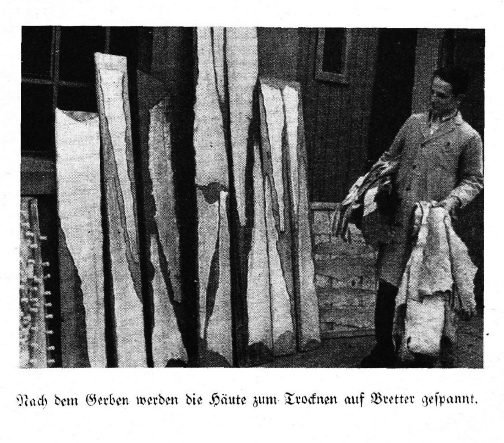The article recaps many of the themes around using fish in binding from austerity measures, to self-reliance (no foreign sources), but also to the unique and beautiful variations of the raw material. It references the long history of using fish in Ainu and Siberian (polar) cultures, before discussing the material properties of fish skin, common misconceptions (Oh, the stench...!), and processes for preserving the skin from tanning to making parchment. Martini's article from 1919 is cited, but not by name, neither is there (as expected) a mention of Ernst Collins' articles just 4 years earlier in the bookbinding trade journals. Much of the article describes the most common/suitable for binding species; salmon, pollack, wolf fish, cod, lingcod, flounder, shark, and eel among others. Woven in are also tips for working and descriptions of the aesthetic properties, and suitable uses.
Weisse also speaks to books bound in fish that were shown in exhibits, clearly rejecting many decorative and metaphoric applications that to him are easy outs and too simplistic – not worthy of the infinite variations and natural characteristics of the skins. As an example, don't use flounder on a binding about the Alps... "We can (must) do better!" He further states that to make use of the material as second nature as that of Morocco or calf vellum it must be more than just a temporal fashion statement... It is our "duty" as German workers in the skilled trades, in this case bookbinding. Apropos exhibits, the Archiv fuer Buchgewerbe recapped a 1918 exhibition of Franz Martini's bindings made from Klippfish (stock fisch, salted cod) parchment at the Deutschen Kulturmuseum für Buch und Schrift in Leipzig. Also mentioned were the tests undertaken on Martini's fish parchment.
Note the size of the fish in these images, most caught closer to their markets as factory-scale fishing was not as common then. Compare with the fishes we see now. A clear sign of over-fishing.
 |
| Skinning the fish. Note, the fillet is placed skin down and skinned that way, kind of like paring leather. |
 |
| The remaining bits of flesh and scales are removed in a process similar to de-hairing mammalian skins prior to making parchment or tanning. |
 |
| The skins are stretched unto boards with nails. |
 |
| After tanning, the skins are stretched out on boards to dry. |
 |
| The finished fish leathers in the hands of the Meister who is examining it for aesthetics and usefulness. "What binding is this most appropriate for...?" |
Book Arts arts du livre Canada (Vol 10., Nr. 2, 2019)
"Fish Tales, experiments with fish skin for bookbinding
The New Bookbinder: Journal of Designer Bookbinders (2020)
"Fish Tales, experiments with fish skin for bookbinding
The New Bookbinder: Journal of Designer Bookbinders (2020)
